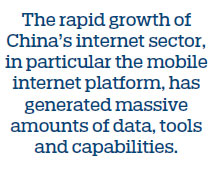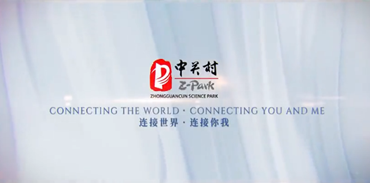Where digitization goes next
In China, the process is extending beyond consumers. Internet giants are now eyeing the industrial internet, an area previously underdeveloped
The need for digitization is no longer a matter of debate. Digital transformations are taking place across industries, changing the business landscape and transforming traditional business models.
Ten years ago, only one of the top global companies was a tech firm. Now, there are seven tech companies in the top 10.
In China, the digital market's meteoric growth has led to the development of five of the largest public internet companies in the world: Tencent, Baidu, Alibaba, JD.com and Netease.
The rapid growth of China's internet sector, in particular the mobile internet platform, has generated massive amounts of data, tools and capabilities. And China's internet giants have revolutionized many aspects of consumers' daily lives.
For example, Didi's ride-sharing app served more than 20 million riders a day in 2017, surpassing Uber's ridership worldwide. And just a year after smart speaker technology was introduced, China accounted for more than 35 percent of its sales worldwide.
However, China's digitization is now extending far beyond the consumer sphere. Internet giants have now set their sights on the industrial internet, an area previously underdeveloped.
They have launched digital platforms that are transforming industries, covering everything from manufacturing and design to supply chains and logistics.
Alibaba has built platforms such as Lingshoutong that have digitized more than 1 million mom-and-pop grocery stores, and Luckin Coffee has grown rapidly with a model that combines an online front end and offline delivery service. It opened 1,700 shops in the first 11 months of operation by driving online customer acquisition. It has now grown to a scale that rivals Starbucks.
Furthermore, established industrial players such as Haier, Sany and XMCG are building digital industrial platforms that are enabling SMEs to digitize their operations. These developments have accelerated the digitization of upstream production and will allow Chinese companies to make greater strides in emerging technologies such as autonomous driving. The leader in this space is Baidu, whose open platform, Apollo, has attracted more than 130 automotive industry partners from across the value chain.

The Chinese government, too, has played an instrumental role in driving the development and adoption of key technologies, providing strong policy support for research into artificial intelligence with the launch of the State Council's New Generation AI Development Plan.
In many ways, global internet giants have innate advantages in the digitization race, having built digital capabilities and processes from the ground up, but for newcomers the challenge is much greater.
Many start by digitizing one step or process in their business, such as building a data platform. More enterprising firms seek to recreate their models around digital technologies. However, digital leaders are building integrated and autonomous learning systems that are connected in a self-reinforcing system.
These systems are able to generate new options, through experimentation with different initiatives and continual adjustment. Alibaba is a good example. Its e-commerce platforms Taobao and Tmall collect a vast amount of user data, which the company can then analyze to generate detailed insights and thereby adjust its product offering in real time, say, by changing its search results, advertising or product recommendations. This continuous process of self-learning helps the company become more efficient over time.
Collaboration within industries is also becoming more multilateral. For example, in the automobile industry, original equipment manufacturers are no longer simply collaborating on the basis of simple bilateral contractual relationships. They are engaging with a much wider range of partners, including service platforms, app platforms, telecom providers, and cloud or Internet of Things platforms.
The need for more agile and adaptive organizations is prompting companies to redesign their organizational structures. Many are adopting platform-like structures, in a shift away from top-down management toward greater enablement.
Teams need to become more cross-functional and autonomous, but they are still supported by strong platforms and a governance structure that enables more flexible modes of collaboration.
The process of organizational readjustment generally takes place in stages. Companies first experiment with small projects to gain "quick wins", then build a digital center of excellence within each function, to enable centralized management. In the next stage, the company expands digital capabilities across the organization, putting business units in the driving seat, before embedding digitization fully into the company's processes and DNA.
The business model changes we have witnessed so far are just the beginning of a digitally enabled business revolution. Technologies are changing so quickly that businesses must constantly reinvent themselves to stay ahead. They must adopt self-learning models that enable constant improvement and agile ways of work in order to remain flexible enough to win in the digital era.
Success in the age of digitization is by no means guaranteed. Companies that take an adaptive approach to digital strategy and develop capabilities rapidly in response to market changes will have the greatest chance of staying relevant.
The author is president and CEO of the Boston Consulting Group.The author contributed this article to China Watch, a think tank powered by China Daily. The views do not necessarily reflect those of China Daily.


